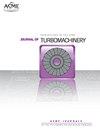模拟非定常多阀芯相互作用的谐波方法
IF 3.1
3区 工程技术
Q3 ENGINEERING, MECHANICAL
引用次数: 0
摘要
摘要现代民用喷气发动机为了提高压气机失速余量和发动机整体性能等,将部件布置在不同转速的轴上。这些部件之间的非定常相互作用可能是显著的,如果可能的话,应在早期设计阶段考虑。非定常reynolds -average Navier-Stokes (URANS)是模拟这些非定常效应的常用方法,但在多轴模拟中,时间尺度的差异会导致URANS模拟成本高昂。谐波方法是模拟叶轮机械部件间非定常相互作用的有效方法,但其在多阀芯仿真中的应用仍然是一个挑战。本文的目标就是解决这一挑战。本文扩展了favr -平均非线性谐波方法,采用统一的叶片界面,在任意转速下通过任意叶片数的叶片传递扰动,来模拟多轴叶轮机械部件。讨论了零频模式下一定周向波数下非反射边界条件的正则化问题。通过在三轴发动机中模拟热斑在全三维高中压涡轮中的传递,证明了该方法的能力。从平均流场和瞬时流场来看,谐波法得到的温度分布与直接非定常模拟结果吻合较好。所提出的谐波方法能很好地捕捉到热斑向轮毂的径向迁移。谐波法所需的挂钟时间比全环空URANS模拟所需的挂钟时间大约小240倍。这表明,所提出的方法可以作为一种有效的设计工具,在多轴涡轮的早期设计阶段跟踪热条纹。本文章由计算机程序翻译,如有差异,请以英文原文为准。
Harmonic Method for Simulating Unsteady Multispool Interactions
Abstract Modern civil jet engines arrange components on spools with different rotational speeds in order to improve compressor stall margin, overall engine performance, etc. The unsteady interactions among these components can be significant and should be considered at an early design stage if possible. Unsteady Reynolds-averaged Navier–Stokes (URANS) is a common approach to simulate these unsteady effects, but the disparity in time scales in a multispool simulation can lead to expensive URANS simulations. Harmonic methods are effective and efficient approaches to simulate unsteady interactions among turbomachinery components, but their applications to multispool simulations remain a challenge. The objective of this paper is to address this challenge. This paper extends the Favre-averaged non-linear harmonic method to simulate multispool turbomachinery components using a unified bladerow interface which transfers disturbances through bladerows with arbitrary blade counts at any rotational speed. The regularization of non-reflective boundary condition is described for certain circumferential wave number of the zero-frequency mode. The capability of the proposed approach is demonstrated by simulating the transfer of hot streaks through full 3D high- and intermediate-pressure turbines in a three-shaft engine. The temperature distributions from the harmonic method show good agreement with direct unsteady simulation in terms of the mean flow and the instantaneous flow. The radial migration of the hot streaks towards the hub are captured very well by the proposed harmonic method. The required wall-clock time of the harmonic method is roughly 240 times smaller than the whole annulus URANS simulation. This demonstrates that the proposed method can be an efficient design tool to trace hot streaks in multispool turbines at the early design stage.
求助全文
通过发布文献求助,成功后即可免费获取论文全文。
去求助
来源期刊
CiteScore
4.70
自引率
11.80%
发文量
168
审稿时长
9 months
期刊介绍:
The Journal of Turbomachinery publishes archival-quality, peer-reviewed technical papers that advance the state-of-the-art of turbomachinery technology related to gas turbine engines. The broad scope of the subject matter includes the fluid dynamics, heat transfer, and aeromechanics technology associated with the design, analysis, modeling, testing, and performance of turbomachinery. Emphasis is placed on gas-path technologies associated with axial compressors, centrifugal compressors, and turbines.
Topics: Aerodynamic design, analysis, and test of compressor and turbine blading; Compressor stall, surge, and operability issues; Heat transfer phenomena and film cooling design, analysis, and testing in turbines; Aeromechanical instabilities; Computational fluid dynamics (CFD) applied to turbomachinery, boundary layer development, measurement techniques, and cavity and leaking flows.

 求助内容:
求助内容: 应助结果提醒方式:
应助结果提醒方式:


